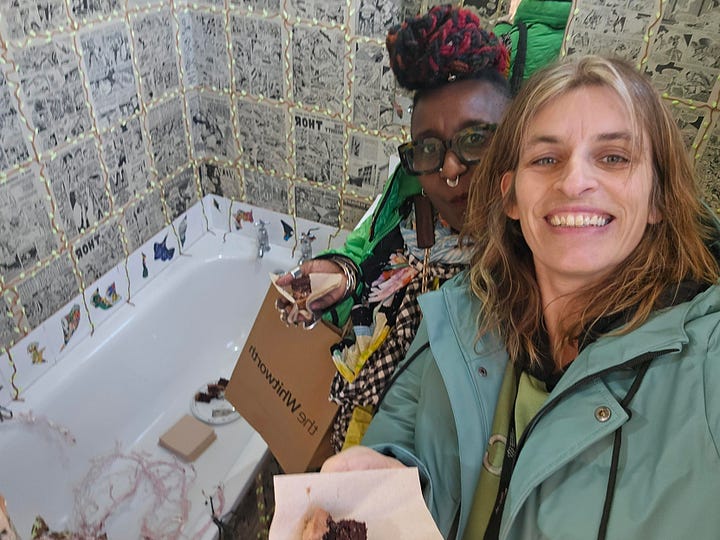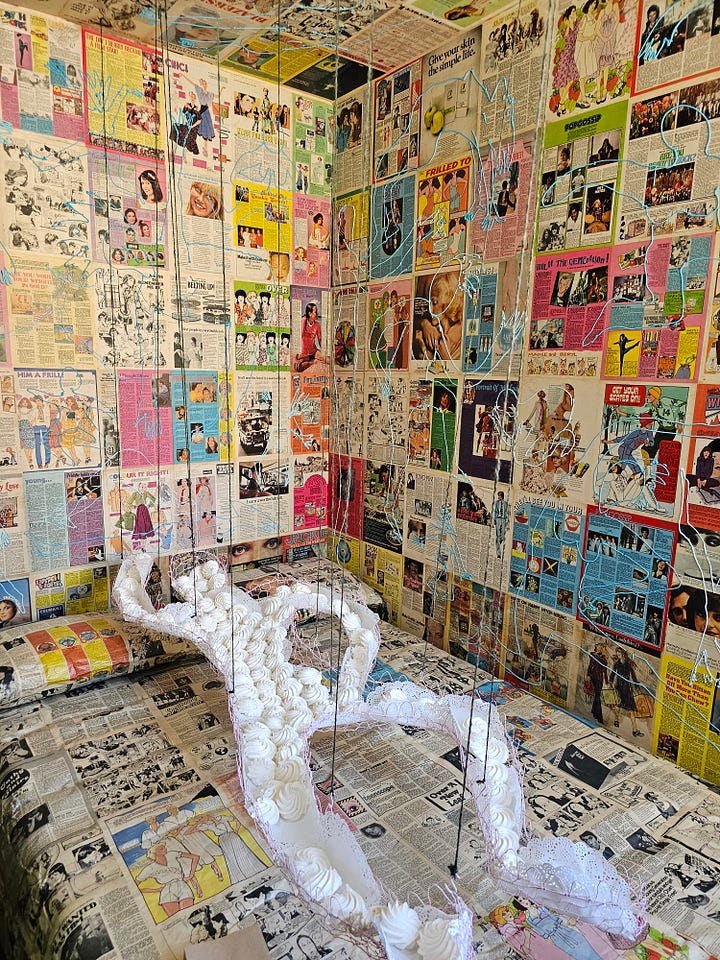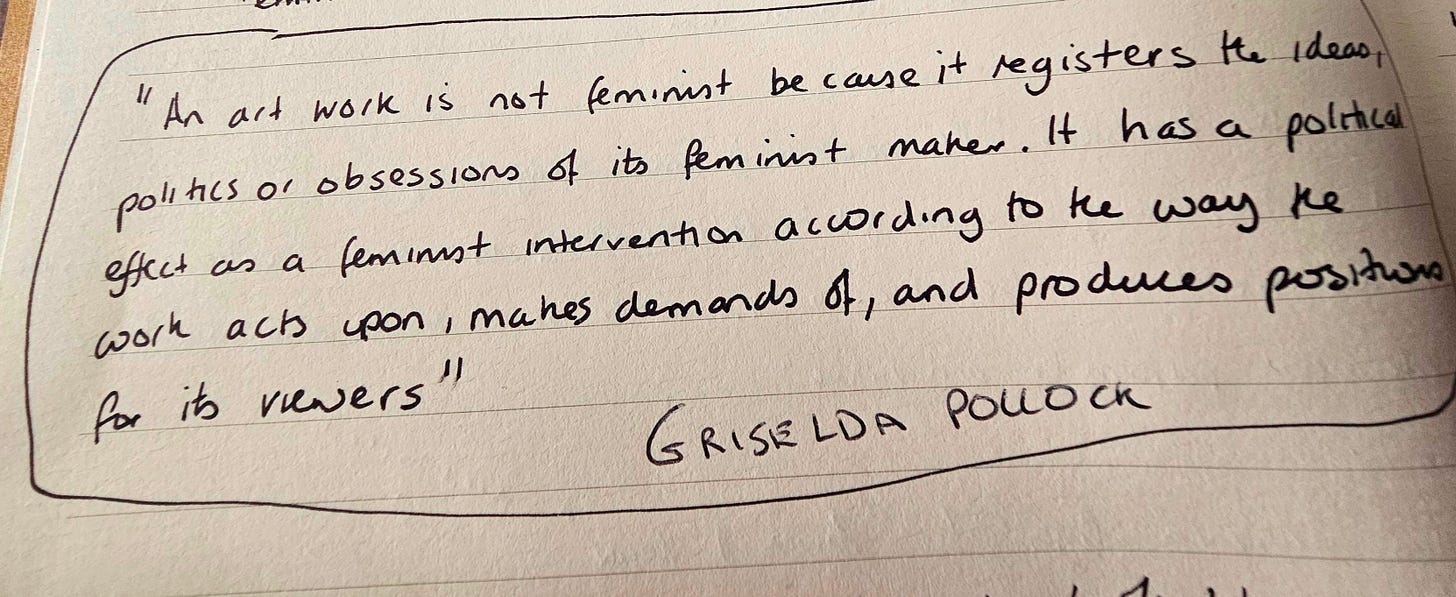One of the things that I love about my job, even now I work full time in a university is that no day is the same. Sometimes I get asked what a poet does, most often by my dad, who is still outraged about the time I answered his question by saying “I took a full stop out of a poem and put it in again”. I said this to annoy him, it’s quite rare that I get a day to obsess about a full stop (or not) but inspired by Clare’s recent posts about working with small children, I thought I’d start a new series of posts called ‘What do poets do all day’ where I will attempt to pull back the veil on what this poet, at least does, on a particular day.
Today my husband and daughter have gone off on a camping trip for a few days, so I have the house to myself, which is very rare. I have the last week of university teaching next week and this term has been so intense and full on that I couldn’t cope with the thought of camping and then rushing back for my teaching, so I have stayed at home.
This morning I got a lift with them out to Luddenden and ran back along the ‘clearway’ a path that runs mostly alongside the train track and means I can avoid the geese on the canal who are going into full on psycho mode, and also avoid the traffic on the main road through the valley. I got back to Hebden, got the bus up the hill (I’m a runner not a masochist!) and then showered, made myself some lunch and then Clare Shaw appeared to do some writing.
Clare announced they were working on the last part of their next collection and I decided I would have a look at my manuscript as well, after a long break from it to start some edits that have been niggling at my mind for a while.
So my editing job today was to sort out “Damaged Cento” which avid readers of this blog will know was published relatively recently in The Stinging Fly, edited by the brilliant poet Annemarie Ní Churreáin. I will just give a courtesy note here for discussions of domestic violence, homicide, abuse and stalking, just in case anyone would prefer not to read on further.
I wrote recently about this poem on Substack, and you can find the original post here Damaged Cento, which you might perhaps like to read (if you haven’t already) to get a little context. The poem draws on the Cento form, which is usually a form made of lines of other people’s poems (all fully credited of course), but this is a damaged cento, because those poetic lines are interrupted by the academic research which outlines each stage of relationship development.
In that original post, I talk about the academic research that the poem draws upon, which was carried out by Jane Monckton Smith. Smith identified eight stages that a relationship goes through before domestic homicide takes place, and the identification of these eight stages means that the development of a domestic homicide is in some ways predictable. You can find the original article, which is available to download as a PDF here “Intimate Partner Femicide: using Foucauldian analysis to track an eight stage relationship progression to homicide. Violence Against Women.”
One of the reasons I wanted to write the poem was to raise awareness about these different stages, and there’s been something niggling at me since the poem was published, and following more recent performances of the poem. I also wanted to de-mystify a little the editing process but also talk about how long editing can take, and that sometimes the poem still has more to teach us, more to show us.
Here it is, in its original version.
DAMAGED CENTO I wanted to write a cento about light – full of enchanted streetlamps and the slipping of light against the hills but I’m reading about the eight stages of relationship development before domestic homicide takes place and so nothing comes out right – stage 1 – the man always has a history of abuse or stalking – the moon, cracked every which way pushes steadily on – stage 2 – a commitment whirlwind begins – thought followed thought, star followed star – stage 3 – the relationship develops – is love not this? gripping a fence in the sky – stage 4 is the trigger – leaving, pregnancy, illness – when the blossoms are wilting, I cut the stalk – stage 5 is escalation - shot through with stars, fluttering with sparrows and quails – stage 6 is a change of heart – you are in the dark, in your car, watching the black-tarred street being swallowed by speed – stage 7 is planning – the sun and the hole vie for attention – stage 8 is homicide - the moon, cracked every which way, pushes steadily on. *italicised sources – David Morley, Carola Luther, Adrienne Rich, Emily Brontë, Rachel Long, Sharon Olds, Moniza Alvi, Claudia Rankine, Moniza Alvi, Adrienne Rich.
One of the things I’m wrestling with at the moment is stage 3, and stage 5. I’m not happy with stage 3. Stage 3 is one of the most diverse stages in a violent relationship in terms of the timeline. It is where coercive control really starts and subsequently takes hold, and as Monckton Smith points out, it can last ‘as little as 3-6 weeks, in others it was as long as 50 years.’ I didn’t feel my summary of this stage would give anyone enough information about what happens. At the moment it just reads ‘stage 3 - the relationship develops -’. All relationships develop, but there are specific patterns in an abusive relationship that make them abusive. I started to make lists of words and phrases.
In Monckton Smith’s article, she talks about how coercive controlling behaviour is often not ‘read’ or ‘understood’ as that - so possessiveness is read as caring, or jealousy is read as love. Below are some of the notes from my notebook.
In the end, I went back again to Monckton Smith’s article, and noted down the phrase ‘controlling patterns’ and how much she emphasises the word ‘pattern’, and finally came up with this:
stage three – the relationship develops with patterns of control –is love not this? gripping a fence in the sky –
I think I am happier with this - I think it’s important to have the ‘patterns of control’ in, but it also pushes against the line from Rachel Long, where a speaker asks themself whether what they are experiencing is love. This addition has of course shifted all the line breaks around so that has taken some working out.
The other bit that was bothering me, again with its lack of specificity was stage 5, which in the original version, I’ve identified as being marked by escalation. I think you do get a sense of violence, but I’m relying on the line of poetry from Moniza Alvi to do a lot of the heavy lifting here (shot through with stars, fluttering with sparrows and quails). Again, I went back to the original article which has such useful descriptions of each stage.
What do we mean by escalation? What types of behaviour tend to escalate at this stage? Smith outlines that at this stage, “This could involve a variety of behaviours with perpetrators using a number of tactics to re-establish their control, like begging, crying, threats of violence, violence, stalking, or suicide threats.” I’ve edited this down, so now this section of the poem reads:
stage five is escalation – there may be
begging, crying, threats of violence, stalking –
shot through with stars, fluttering with sparrows and quails – I wanted behaviour in there that could be read as victim like behaviour, or even signs of great devotion or love - begging and crying alongside threats and stalking. Often these behaviours can happen alongside each other and it can be difficult to distinguish them as controlling.
One of the other things that led to editing a poem that I thought a few months ago was finished is I’ve been reading a book called Art Monsters by Lauren Elkin, which is an AMAZING book and you should all go and buy it and read it at once. I would like (when I have time ha!) to do a post just about this book, but I will press on for now.
In it, Elkin quotes the great feminist art historian Griselda Pollock, who wrote in Framing Feminism: Art and the Women's Movement, 1970-85 that:
When I read this, I felt as if fireworks were going off in my mind. It is exactly what I wanted my last collection All the Men I Never Married to do. Not just to say isn’t sexism terrible, but to ‘act upon, make(s) demands of and produce(s) positions’ for in my case readers and audience members.
It’s not that I think every poem has to do this, or should do this, but I realised it’s what I want “Damaged Cento” to do. Once we know about the eight stages of relationship development, once we read about them, once we know what they look like, can any of us stay silent? What would the world look like if we talked about these things, if we named when we thought they might be happening?
Here is the new version of the poem. As they stand, they are pretty small changes in the grand scheme of things, and don’t look like much for an afternoon’s work. But they are important to me because I feel as if I’ve been listening to the poem, and learning from it still, and as if the reading from Art Monsters is feeding into my writing, and developing my thinking further.
DAMAGED CENTO I wanted to write a cento about light, full of enchanted streetlamps and the slipping of light against the hills but I can’t stop thinking about the eight stages of relationship development before domestic homicide takes place and so nothing comes out right. Stage one – the man always has a history of abuse or stalking – the moon, cracked every which way pushes steadily on – stage two – a commitment whirlwind begins – thought followed thought, star followed star – stage three – the relationship develops with patterns of control – is love not this? gripping a fence in the sky – stage four is the trigger – leaving, pregnancy, illness – when the blossoms are wilting, I cut the stalk – stage five is escalation – threats of violence, begging, crying, stalking – shot through with stars, fluttering with sparrows and quails – stage six is the decision to move on, to revenge, to homicide - you are in the dark, in your car, watching the black-tarred street being swallowed by speed – stage seven is planning – the sun and the hole vie for attention – stage eight is homicide - the moon, cracked every which way, pushes steadily on. *italicised sources – David Morley, Carola Luther, Adrienne Rich, Emily Brontë, Rachel Long, Sharon Olds, Moniza Alvi, Claudia Rankine, Moniza Alvi, Adrienne Rich.
Sometimes when I’m working with students or mentees there is a place in the poem where a wall has been built in language, and I ask them to ‘lean into this’ a little more, which even as I say it, I hate myself because it sounds so vague and wishy-washy. Except I mean exactly what it says, if we lean into the language in these places, sometimes they open up into a clearer space, or onto a whole new road.
One of the questions I’m asking myself now is if feminist art ‘acts upon, makes demands of and produces positions for its viewers’ what can feminist poetry do? How do we write that type of poetry? Who are the poets (male/female/non-binary/ etc) writing this type of work? Who are the poets who invite us to change our position, to change the way we move through the world? I would love to read some of your suggestions - my go-to poet in this regard are Claudia Rankine, but I’m also thinking of people like Joelle Taylor, Sharon Olds…but I’m interested in your ideas and suggestions.
Finally, I’d like to leave you with this photo of myself and the poet Malika Booker. Last Friday we took a group of students to The Whitworth Gallery to see the Women In Revolt! exhibition (which is brilliant - you should all go and see it if you are anywhere near Manchester).
Here we are inside the art installation of Bobby Baker, The Edible Family. After all that talk about violence, I wanted to finish on sisterhood, on community, on friendship, and of course, eating chocolate cake, which just happened to be a piece of art.








As a Second Wave Feminist the issues you write/protest about are all too familiar. Sometimes it feels that little has changed in 50 years and I’m screaming ‘How can this still be happening.’ But of course a lot has changed and it’s down to people like you not being afraid to speak out, to challenge, to raise awareness. I thank you for that. It takes great courage. 🤗
Lots of echoes, you've tickled my curiosity to write, which has been on floor these last few months. Thank you.